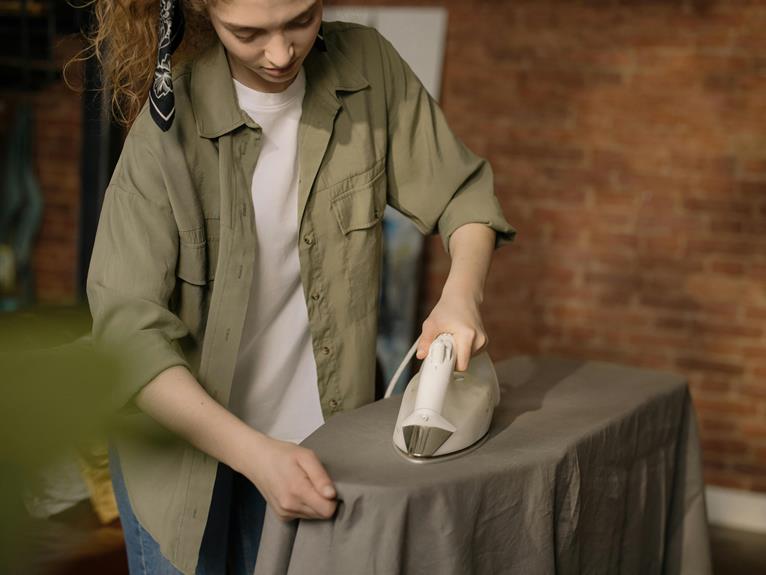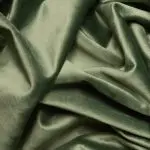When it comes to caring for poplin, you need to pay attention to both washing and ironing techniques to keep it looking its best. Start by washing it in warm water with a mild detergent, but be cautious with stains—pre-treating them properly can make a significant difference. Ironing requires a medium heat setting, and using a damp cloth can help release wrinkles effectively. However, you might be wondering about the best drying methods and storage practices to maintain the fabric's integrity over time. Let's explore those next.
Table of Contents
Key Takeaways
- Wash poplin in warm water (30-40°C) with a mild detergent to maintain color and texture.
- Pre-treat stains with a gentle detergent or specialized stain remover, letting it sit for 5-10 minutes before rinsing.
- Air dry poplin or use a low heat setting in the dryer, removing items while slightly damp to reduce wrinkles.
- Iron poplin at medium heat, using steam or a damp cloth for easier wrinkle removal and always avoid direct heat on fabric.
Understanding Poplin Fabric
Poplin fabric is a tightly woven material known for its smooth texture and durability, making it a popular choice for clothing and home textiles. You'll often find it in shirts, dresses, and bed linens, thanks to its soft feel and crisp appearance. The fabric typically consists of a blend of cotton and polyester, which enhances its breathability while providing a lightweight quality.
When you touch poplin, you'll notice its fine, almost silky finish, which is one reason it drapes beautifully. This fabric is also resistant to wrinkles, making it ideal for everyday wear. Poplin's construction gives it a slight sheen, which can elevate your outfits for both casual and formal occasions.
In terms of colors and patterns, you'll see a wide array of options, from solid hues to intricate prints. This versatility allows you to express your personal style effortlessly. Whether you're dressing up for a special event or looking for comfortable loungewear, poplin fabric has got you covered.
Understanding these characteristics will help you appreciate poplin's role in your wardrobe and home decor.
Washing Poplin: Best Practices
When washing poplin, you'll want to pay attention to the water temperature, as it can affect the fabric's durability.
Choosing the right detergent is also crucial to keep your poplin looking its best.
Ideal Water Temperature
Washing poplin in warm water helps maintain its vibrant colors and crisp texture while effectively removing dirt and stains. For the best results, you should keep the water temperature around 30 to 40 degrees Celsius (86 to 104 degrees Fahrenheit). This range helps to preserve the fabric's integrity and prevents fading.
Here are three key points to remember about water temperature when washing poplin:
- Warm Water Benefits: Warm water penetrates the fabric fibers better, loosening dirt and grime without causing damage.
- Avoid Hot Water: Using hot water can lead to shrinkage and fading of colors, so stick to a warm setting to keep your poplin looking fresh.
- Cold Rinse: For the final rinse, consider using cold water. This helps set the colors and prevents any potential fading from the warm wash.
Detergent Selection Tips
Choose a mild detergent specifically formulated for delicate fabrics to keep your poplin looking its best. Harsh detergents can strip the fibers and cause fading, so it's crucial to select one that's gentle yet effective. Look for products labeled as 'gentle,' 'free and clear,' or 'for delicate fabrics.' These options are usually free from dyes and fragrances that could irritate the fabric or your skin.
When you're out shopping, consider eco-friendly detergents as well. They often contain fewer harsh chemicals, making them a safer choice for your poplin and the environment. Always check the care label on your poplin items; some may have specific detergent recommendations.
Avoid using bleach or fabric softeners, as these can damage the fabric's integrity and alter its texture. Instead, if you need to boost whiteness or tackle stains, try a color-safe oxygen bleach.
Using the right detergent not only helps maintain the quality of your poplin but also enhances its longevity. So, take a little extra time to choose wisely, and your poplin will thank you with years of vibrant wear.
Drying Methods Recommended
Properly drying poplin is essential to maintain its crisp appearance and prevent wrinkles. Using the right drying methods can help you keep your poplin looking fresh and new. Here are some recommended techniques:
- Air Drying: Whenever possible, hang your poplin items to air dry. This method prevents overheating and helps maintain the fabric's integrity. Use a clothesline or a drying rack, and ensure they're in a well-ventilated area.
- Tumble Drying: If you prefer using a dryer, set it to a low heat setting. High heat can damage the fibers and cause shrinkage, so keep it gentle. Remove the items while they're still slightly damp to minimize wrinkles.
- Avoid Direct Sunlight: When air drying, keep your poplin out of direct sunlight. Prolonged exposure can fade colors and weaken the fabric. Shade is your best friend here.
Stain Removal Techniques
When it comes to keeping your poplin looking fresh, effective stain removal is key.
You'll want to know how to pre-treat stains, which stain removers work best, and the safest cleaning methods for the fabric.
Let's explore these techniques to help you tackle any spills or marks with confidence.
Pre-treating Stains Effectively
To effectively pre-treat stains on poplin, start by gently blotting the area with a clean cloth to absorb any excess liquid. Avoid rubbing, as this can spread the stain further.
Once you've blotted the stain, follow these steps for the best results:
- Identify the Stain: Determine what caused the stain. Different substances require different treatment methods. For example, grease, ink, or food stains may need specific approaches.
- Choose a Pre-treatment Method: Depending on the stain type, select an appropriate pre-treatment. You might use a mix of water and mild detergent or a specialized stain remover. Always test on a hidden area first to ensure it won't damage the fabric.
- Apply and Wait: Apply your chosen treatment to the stain and let it sit for about 5-10 minutes. This waiting period allows the solution to penetrate and break down the stain, making it easier to wash out later.
After pre-treating, rinse the area with cold water and proceed with washing the poplin as usual.
Proper pre-treatment can make a significant difference in removing stubborn stains.
Recommended Stain Removers
Choosing the right stain remover can make all the difference in keeping your poplin looking fresh and clean.
For water-based stains, like coffee or juice, a gentle dish soap mixed with cold water works wonders. Apply it directly to the stain, gently blotting with a clean cloth until the stain lifts. Rinse thoroughly afterward.
For oil-based stains, like salad dressing or makeup, reach for a stain remover specifically designed for grease. Apply it to the stain, letting it sit for about 10 minutes before rinsing. You can also try a mix of baking soda and water to create a paste for stubborn stains, applying it and letting it sit before rinsing.
If you're dealing with ink stains, use rubbing alcohol or hand sanitizer. Dab a small amount onto the stain and blot until you see the ink lift.
Always test any stain remover on a hidden area of your poplin first to ensure it won't damage the fabric.
Fabric-Safe Cleaning Methods
Utilizing fabric-safe cleaning methods ensures your poplin stays vibrant and undamaged while tackling stains effectively. To maintain the integrity of your poplin fabric, you'll want to use gentle yet effective techniques for stain removal. Here are three methods that work wonders:
- Cold Water Rinse: For fresh stains, immediately rinse the affected area under cold water. This helps lift the stain without setting it into the fabric.
- Gentle Detergent: Use a mild detergent specifically formulated for delicate fabrics. Apply a small amount directly to the stain, gently rubbing it with your fingers or a soft cloth to avoid damage.
- Vinegar Solution: Mix equal parts white vinegar and water in a spray bottle. Lightly spray the stained area and let it sit for about 10 minutes before blotting with a clean cloth. This natural solution can effectively break down many stains.
After treating the stain, wash your poplin according to the care instructions, and never use hot water or harsh chemicals, as they can harm the fabric.
Drying Methods for Poplin
When drying poplin, you can either air dry or use a dryer on a low heat setting to prevent shrinking and maintain its smooth texture. If you choose to air dry, hang your poplin items on a clothesline or a drying rack in a well-ventilated area. This method helps retain the fabric's integrity and keeps it looking fresh.
If you opt for the dryer, remember to use a low heat setting and remove the items while they're still slightly damp. This minimizes creasing and the risk of heat damage. Whichever method you choose, avoid direct sunlight, as it can fade the fabric colors over time.
Here's a quick comparison of the two drying methods:
| Drying Method | Pros |
|---|---|
| Air Dry | Gentle on fabric, no shrinkage |
| Dryer | Quick, convenient |
Ironing Tips for Perfect Results
To achieve perfectly pressed poplin, always start with a clean iron and set it to the appropriate heat level for the fabric. Poplin is typically best ironed on a medium heat setting.
Here are some tips to ensure great results:
- Dampen the Fabric: Lightly spray the poplin with water or use the steam function on your iron. This helps relax the fibers, making it easier to remove wrinkles.
- Iron in Sections: Work on one section at a time. Start with the collar or cuffs, then move to the body of the garment. Use smooth, even strokes while avoiding excessive pressure, which can damage the fibers.
- Use a Pressing Cloth: Place a thin, clean cloth between the iron and the poplin. This protects the fabric from direct heat and helps maintain its finish, especially if you're dealing with delicate designs or embellishments.
Storing Poplin Properly
Storing poplin properly ensures it maintains its smooth finish and vibrant colors for years to come. Start by folding your poplin garments neatly. Avoid hanging them, as this can cause stretching or distortion. Instead, lay them flat or fold them in a way that minimizes creasing. Use acid-free tissue paper between layers if you're stacking multiple items to prevent friction and potential color transfer.
Keep your poplin in a cool, dry place away from direct sunlight. Excessive heat and humidity can lead to fading and damage. For long-term storage, consider using breathable garment bags that allow air circulation while protecting against dust.
If you're storing poplin in a drawer or closet, ensure it's clean and completely dry. Any moisture can lead to mildew, ruining your favorite pieces. Additionally, avoid storing poplin with heavy items on top, as this may create unwanted creases.
Lastly, regularly check on your stored poplin to ensure it's in good condition. With these simple steps, you can keep your poplin looking fresh and vibrant, ready to wear whenever you need.
Frequently Asked Questions
Is Poplin Fabric Suitable for Sensitive Skin Types?
Yes, poplin fabric's smooth texture and breathability make it suitable for sensitive skin types. It's lightweight and often made from cotton, reducing irritation. Just ensure you choose high-quality, untreated poplin for the best comfort.
Can I Dye Poplin Fabric at Home?
Yes, you can dye poplin fabric at home! Just make sure to use a dye suitable for cotton blends, follow the instructions carefully, and prepare the fabric properly for the best results. Enjoy your creative project!
What Are Common Uses for Poplin Fabric?
Poplin fabric's commonly used for shirts, dresses, and lightweight jackets. You'll find it in home decor items like curtains and tablecloths too. Its smooth texture and durability make it a favorite for various clothing applications.
How Does Poplin Compare to Other Fabrics?
When you compare poplin to other fabrics, you'll notice it's lightweight yet durable. It resists wrinkles better than cotton, feels smooth against your skin, and offers versatility for various clothing styles and home textiles.
Is Poplin Fabric Eco-Friendly?
Poplin fabric can be eco-friendly, depending on its source. If it's made from organic cotton or sustainably sourced fibers, it's a better choice for the environment. Always check the label for eco-certifications.
- Tetron Fabric for Marine Applications: Durability and Use Cases - June 18, 2025
- Tetron Fabric for Outdoor Furniture: Weather Resistance and Care - June 18, 2025
- Tetron Fabric for Wall Coverings: Style and Application Tips - June 18, 2025







